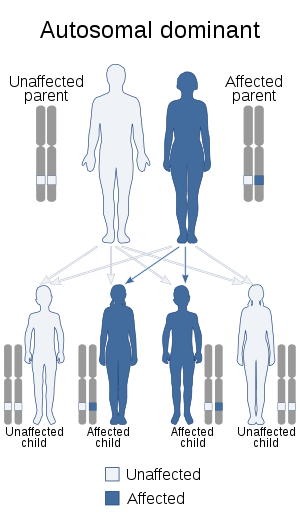Barber–Say syndrome
Barber-Say syndrome (BSS) is a very rare congenital disorder associated with excessive hair growth (hypertrichosis), fragile (atrophic) skin, eyelid deformities (ectropion), and an overly broad mouth (macrostomia).[1]
| Barber Say syndrome | |
|---|---|
| Other names | Hypertrichosis-atrophic skin-ectropion-macrostomia syndrome |
 | |
| Barber-Say syndrome has an autosomal dominant pattern of inheritance | |
| Usual onset | Neonatal |
Barber-Say syndrome is phenotypically similar to Ablepharon macrostomia syndrome, which is also associated with dominant mutations in TWIST2.[2]
Signs and symptoms
- Severe hypertrichosis, especially of the back
- Skin abnormalities, including hyperlaxity and redundancy
- Facial dysmorphism, including macrostomia
- Eyelid deformities, including ectropion
- Ocular telecanthus
- Abnormal and low-set ears
- Bulbous nasal tip with hypoplastic alae nasi
- Low frontal hairline
Genetics
Multiple cases of parent-to-child transmission suggest that Barber-Say syndrome exhibits autosomal dominant inheritance.[3] Exome sequencing and expression studies have shown that BSS is caused by mutations in the TWIST2 gene that affect a highly conserved residue of TWIST2 (twist-related protein 2). TWIST2 is a basic helix-loop-helix transcription factor that binds to E-box DNA motifs (5'-CANNTG-3') as a heterodimer and inhibits transcriptional activation.[4] Because TWIST2 mediates mesenchymal stem cell differentiation[5] and prevents premature or ectopic osteoblast differentiation,[6] mutations in TWIST2 that disrupt these functions by altering DNA-binding activity could explain many of the phenotypes of BSS.[2]
Epidemiology
The prevalence of Barber Say syndrome is less than 1 in 1,000,000.[7] As of 2017, only 15 cases have been reported in the literature.[8]
References
- "Barber Say syndrome | Genetic and Rare Diseases Information Center (GARD) – an NCATS Program". rarediseases.info.nih.gov. Retrieved 2019-01-21.
- Marchegiani S, Davis T, Tessadori F, van Haaften G, Brancati F, Hoischen A, et al. (July 2015). "Recurrent Mutations in the Basic Domain of TWIST2 Cause Ablepharon Macrostomia and Barber-Say Syndromes". American Journal of Human Genetics. 97 (1): 99–110. doi:10.1016/j.ajhg.2015.05.017. PMC 4572501. PMID 26119818.
- Online Mendelian Inheritance in Man (OMIM): BARBER-SAY SYNDROME; BBRSAY - 209885
- Universal protein resource accession number Q8WVJ9 for "TWIST2 – Twist-related protein 2 – Homo sapiens (Human) – TWIST2 gene & protein " at UniProt.
- Isenmann S, Arthur A, Zannettino AC, Turner JL, Shi S, Glackin CA, Gronthos S (October 2009). "TWIST family of basic helix-loop-helix transcription factors mediate human mesenchymal stem cell growth and commitment". Stem Cells. 27 (10): 2457–68. doi:10.1002/stem.181. PMID 19609939.
- Lee MS, Lowe G, Flanagan S, Kuchler K, Glackin CA (November 2000). "Human Dermo-1 has attributes similar to twist in early bone development". Bone. 27 (5): 591–602. doi:10.1016/S8756-3282(00)00380-X. PMID 11062344.
- "Orphanet: Barber Say syndrome". www.orpha.net. January 2014. Retrieved 2019-01-21.
- Yohannan MD, Hilgeman J, Allsbrook K (July 2017). "TWIST2 gene mutation". Clinical Case Reports. 5 (7): 1167–1169. doi:10.1002/ccr3.1014. PMC 5494409. PMID 28680619.
External links
| Classification | |
|---|---|
| External resources |